The hardware and bandwidth for this mirror is donated by METANET, the Webhosting and Full Service-Cloud Provider.
If you wish to report a bug, or if you are interested in having us mirror your free-software or open-source project, please feel free to contact us at mirror[@]metanet.ch.
The ggcorrplot package can be used to visualize easily a correlation matrix using ggplot2. It provides a solution for reordering the correlation matrix and displays the significance level on the correlogram. It includes also a function for computing a matrix of correlation p-values.
Find out more at http://www.sthda.com/english/wiki/ggcorrplot-visualization-of-a-correlation-matrix-using-ggplot2.
ggcorrplot can be installed from CRAN as follow:
install.packages("ggcorrplot")Or, install the latest version from GitHub:
# Install
if(!require(devtools)) install.packages("devtools")
devtools::install_github("kassambara/ggcorrplot")# Loading
library(ggcorrplot)The mtcars data set will be used in the following R code. The function cor_pmat() [in ggcorrplot] computes a matrix of correlation p-values.
# Compute a correlation matrix
data(mtcars)
corr <- round(cor(mtcars), 1)
head(corr[, 1:6])
#> mpg cyl disp hp drat wt
#> mpg 1.0 -0.9 -0.8 -0.8 0.7 -0.9
#> cyl -0.9 1.0 0.9 0.8 -0.7 0.8
#> disp -0.8 0.9 1.0 0.8 -0.7 0.9
#> hp -0.8 0.8 0.8 1.0 -0.4 0.7
#> drat 0.7 -0.7 -0.7 -0.4 1.0 -0.7
#> wt -0.9 0.8 0.9 0.7 -0.7 1.0
# Compute a matrix of correlation p-values
p.mat <- cor_pmat(mtcars)
head(p.mat[, 1:4])
#> mpg cyl disp hp
#> mpg 0.000000e+00 6.112687e-10 9.380327e-10 1.787835e-07
#> cyl 6.112687e-10 0.000000e+00 1.802838e-12 3.477861e-09
#> disp 9.380327e-10 1.802838e-12 0.000000e+00 7.142679e-08
#> hp 1.787835e-07 3.477861e-09 7.142679e-08 0.000000e+00
#> drat 1.776240e-05 8.244636e-06 5.282022e-06 9.988772e-03
#> wt 1.293959e-10 1.217567e-07 1.222320e-11 4.145827e-05# Visualize the correlation matrix
# --------------------------------
# method = "square" (default)
ggcorrplot(corr)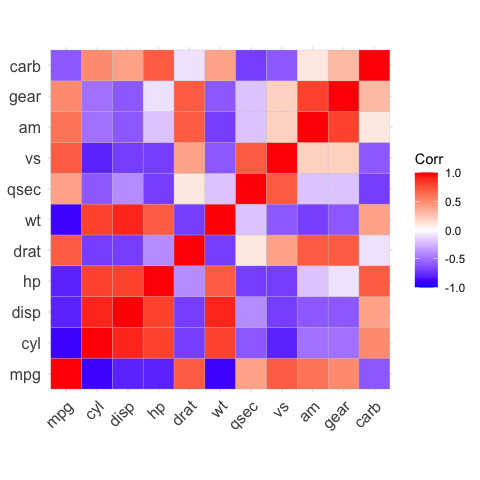
# method = "circle"
ggcorrplot(corr, method = "circle")
#> Warning: `guides(<scale> = FALSE)` is deprecated. Please use `guides(<scale> =
#> "none")` instead.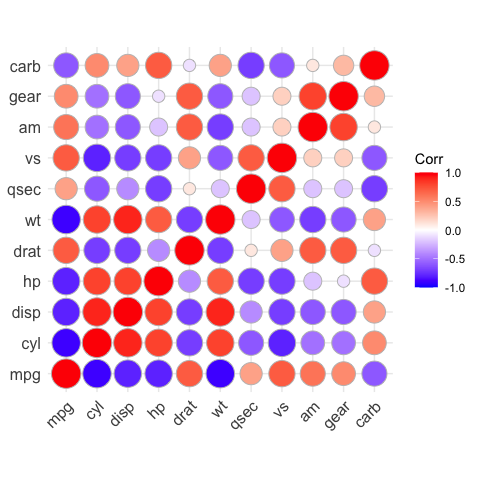
# Reordering the correlation matrix
# --------------------------------
# using hierarchical clustering
ggcorrplot(corr, hc.order = TRUE, outline.color = "white")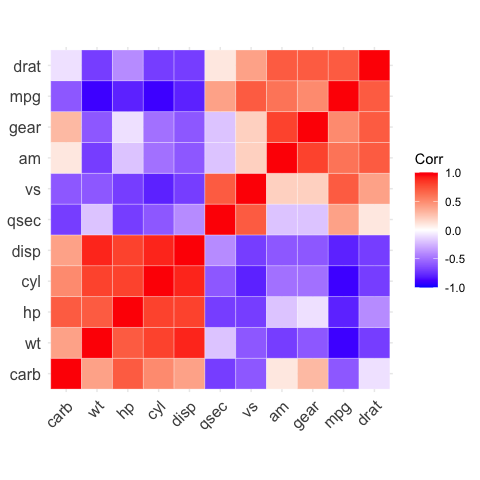
# Types of correlogram layout
# --------------------------------
# Get the lower triangle
ggcorrplot(corr,
hc.order = TRUE,
type = "lower",
outline.color = "white")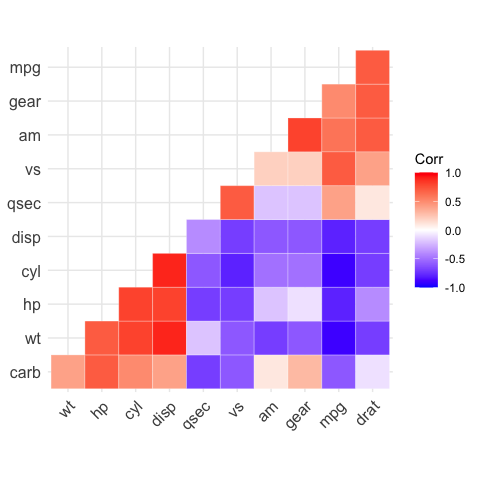
# Get the upper triangle
ggcorrplot(corr,
hc.order = TRUE,
type = "upper",
outline.color = "white")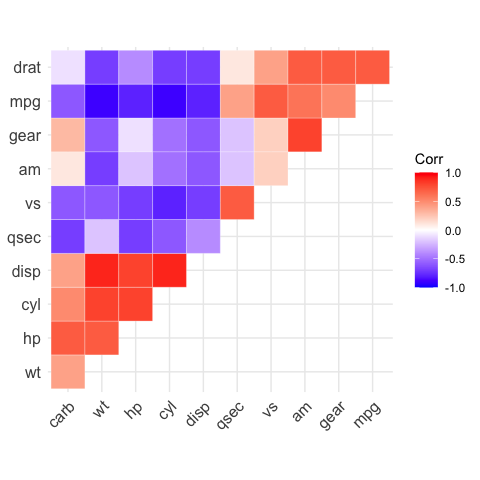
# Change colors and theme
# --------------------------------
# Argument colors
ggcorrplot(
corr,
hc.order = TRUE,
type = "lower",
outline.color = "white",
ggtheme = ggplot2::theme_gray,
colors = c("#6D9EC1", "white", "#E46726")
)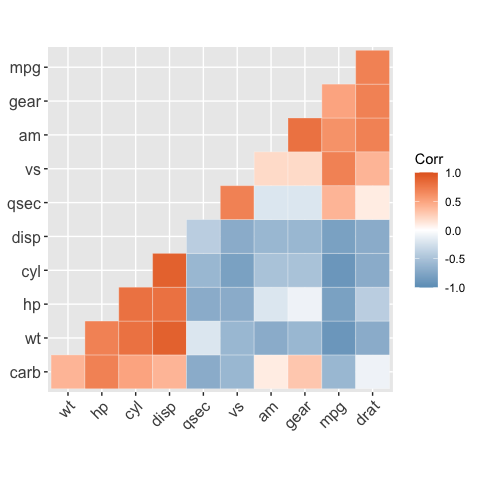
# Add correlation coefficients
# --------------------------------
# argument lab = TRUE
ggcorrplot(corr,
hc.order = TRUE,
type = "lower",
lab = TRUE)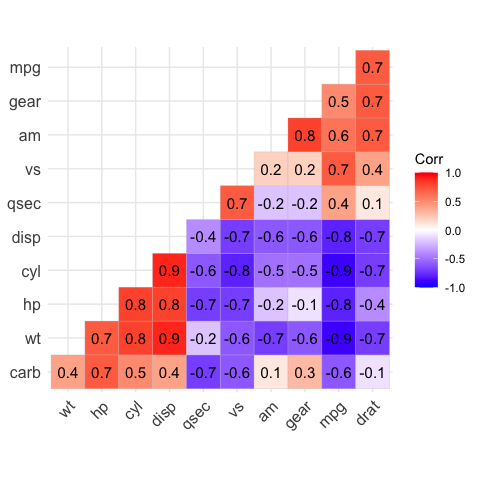
# Add correlation significance level
# --------------------------------
# Argument p.mat
# Barring the no significant coefficient
ggcorrplot(corr,
hc.order = TRUE,
type = "lower",
p.mat = p.mat)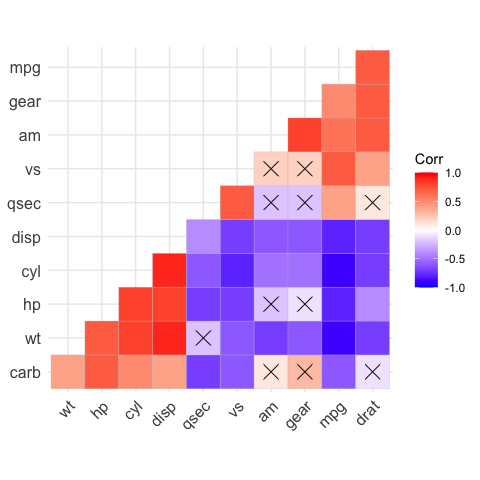
# Leave blank on no significant coefficient
ggcorrplot(
corr,
p.mat = p.mat,
hc.order = TRUE,
type = "lower",
insig = "blank"
)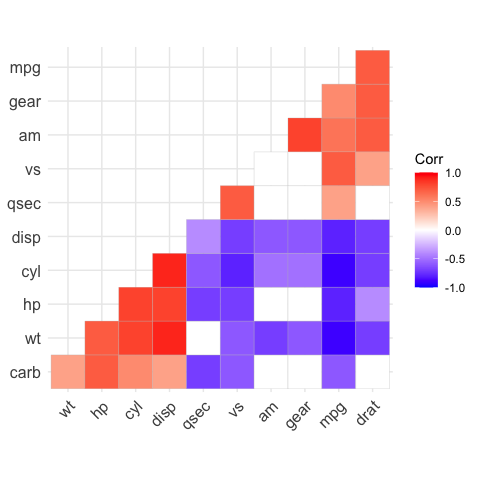
These binaries (installable software) and packages are in development.
They may not be fully stable and should be used with caution. We make no claims about them.